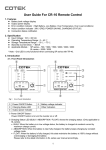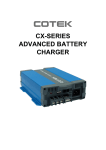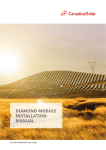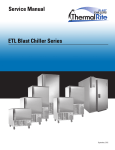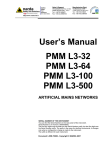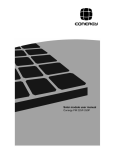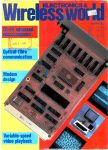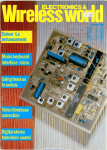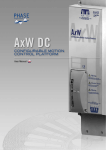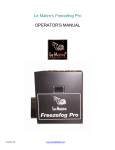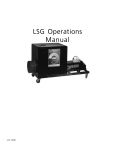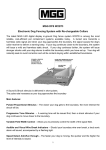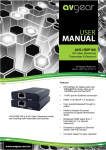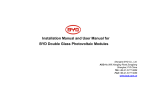Download USER MANUAL Please read this manual carefully
Transcript
ORI Solar Limited USER MANUAL Please read this manual carefully before installing and using the modules. It is the great honor to provide you with our PV modules. In order to enable the PV module to be installed correctly and to generate electric power properly, please read the following operation instruction carefully. 1. Warning: 1 ) . Artificially concentrated sunlight shall not be directed on the module or panel. 2 ) . Under normal conditions, a photovoltaic module is likely to experience conditions that produce more current and/or voltage than reported at standard test conditions. Accordingly, the value of Isc and Voc marked on this module should be multiplied by of 1.25 when determining component voltage ratings, conductor current ratings, fuse sizes, and size of controls connected to the PV output. 3). Do not touch live terminals with bare hands. Use insulated tools for electrical connections. 4). To reduce the risk of electrical shock or burns, modules may be covered with an opaque material during installation to avoid shocks or burns. 5). The installation work of the PV array can only be done under the protection of sun-sheltering covers or sunshades and only qualified person can install or perform maintenance work on this module. 6 ) . Follow the battery manufacture’s recommendations if batteries are used with modules. 7).Fire safety. Refer to your local authority for guidelines and requirements for building or structural fire safety; The roof construction and installation may affect the fire safety of a building, improper installation may contribute to hazards in the event of fire; Use earth ground fault circuit breakers, fuses and ORI Solar Limited circuit breakers as required or necessary; Do not use modules near equipment where flammable gases can be generated or can collect; The modules are rated fire Class C and are suitable for mounting over a Class A roof. 8). All instructions should be read and understood before attempting to install, wire, operate and maintain the module. 2. Unpacking After the PV module has been shipped to the installation site all of the parts should be unpacked properly with care. Caution: The condign environment for unpacking the modules and all other apparatus should be proofed against dampness and rainfall. 3. Preparation before Installation: 1. Optical check before installation, to make sure there is no bug in the packing and junction box as well as the surface of module. 2. Check the series number 3. Check the solar cell modules with irradiance of more than 600W/m2 and get the voltage. In case the voltage is ZERO, it should NOT be installed and please contact the supplier. 4. Tools & Material for Installation ① Screwdriver ② Clamp ③Each mounting hole matches with a set of a screw, a nut and two washer, all made of stainless iron. ④ The users should design and build metallic bracket for installing and bearing the weight of the PV modules. The brackets are specially designed for users’ installation places such as the open land or on the roof of houses. ORI Solar Limited Caution: To avoid damage from flooding and other unpredictable events, and avoid heavy impact. To design a gradient angle facing the sun radiation direction in order to insure the full sunshine receives as much as possible. ⑤ The solar module frame must be attached to a support structure using M8 stainless steel hardware of eight (8) places symmetrical on the solar module. The stainless steel hardware used for securing the module frame should secure with an applied torque of 6 foot-pounds (8 Newton-meters). The recommended standoff height is 20 cm. If other mounting means are employed this may affect the TUV Listing or the fire class ratings, the incline angle α to be adjusted according to local condition. The module has been evaluated by TUV for mounting using the 8 provided mounting holes in the frame. ⑥Way of grounding: All module frames should be grounded for safety. The grounding connections between modules must be approved by a qualified electrician, the grounding itself must be made by a qualified electrician. The ground wire should be at least the same size as the electrical conductors, ground wires no less than 12AWG are recommended. A A ORI Solar Limited 3 1 2 3 4 5 4 WASHER 1. Stainless steel M4 nut 2. Stainless steel serrated washer 3. Stainless steel washer 4. Stainless steel cupped-shape washer 5. Stainless steel M4 t-head bolt 4. INSTALLATION AND OPERATION 1 ) . Systems should be installed by qualified personnel only and at least two persons. The system involves electricity, and can be dangerous if the personnel are not familiar with the appropriate safety procedures. 2). Do not step on the module. 3 ) . Although modules are quite rugged, the glass can be broken (and the module will no longer work properly) if it is dropped or hit by tools or other objects. 4 ) . Put the solar cell modules on the frame and put on the screws and then combine them firmly after put on all the gaskets. All the screw caps should be finished on the frame together firmly. The module frame is made of anodized aluminum, and therefore corrosion can occur if the module is subject to a salt-water environment with contact to a rack of another type of metal. (Electrolysis Corrosion) if required. PVC or stainless steel washers can be placed between the solar module frame and support structure to prevent this ORI Solar Limited corrosion. 5). The solar module frame must be attached to a support structure using M8 stainless steel hardware in a minimum of eight (8) places symmetrical on the solar module. The stainless steel hardware used for securing the module frame should secure with an applied torque of 6 foot-pounds (8 Newton-meters). 6). Module support structures that are to be used to support modules should be wind rated and approved for use by the appropriate local and civil codes prior to installation. 7 ) . When solar modules are used to charge batteries, the battery must be installed in a manner, which will protect the performance of the system and the safety of its users. Follow the battery manufacturer’s guidelines concerning installation, operation and maintenance recommendations. In general, the battery (or battery bank) should be away from the main flow of people and animal traffic. Select a battery site that is protected from sunlight, rain, snow, debris, and is well ventilated. Most batteries generate hydrogen gas when charging, which can be explosive. Do not light matches or create sparks near the battery bank. When a battery is installed outdoors, it should be placed in an insulated and ventilated battery case specifically designed for the purpose. 8). In most applications, PV modules should be installed in a location where they will receive maximum sunlight throughout the year. In the Northern Hemisphere, the modules should typically face south, and in the Southern Hemisphere, the modules should typically face north. Modules facing 30 degrees away from true South (or north) will lose approximately 10 to 15 percent of their power output. If the module faces 60 degrees away from true South (or North), the power loss will be 20 to 30 percent. When choosing a ORI Solar Limited site, avoid trees, buildings or obstructions, which could cast shadows on the solar. 5. Wiring and Connection: 1. Before this procedure, please read the operation instructions of the PV control system carefully. 2. The cable diameter is 4mm2 ,type is PV1-F, 1*4.0mm2.Max. Temperature at conductor is 120℃, Ambient Temperature is -40℃~+90℃. Manufacturer is CiXi Renhe Photovoltaic Electrical Appliance Co., LTD. 3. Make wiring by Multi-connecting cables between the PV modules in series or parallel connection, which is determined by user’s configuration requirement for system power, current and voltage. 4. Open the connection box of the control system and connect the cabled from the PV arrays to the connection box in accordance with the installation indication of the PV control systems. 5. All module frames and mounting racks must be properly grounded in accordance with local and national electrical codes. 6. Do not use modules of different configurations in the same system. The maximum number of modules connected in series (N) = Vmax system / [Voc (at STC)]. The maximum number of modules connected in parallel is not limited, this is determined by the system design such as desired current or power output etc. Several modules are connected in series and then in parallel to form a PV array, especially for application with a high operation voltage. If modules are connected in series, the total voltage is equal to the sum of individual voltages. 7. Follow the requirements of applicable local and national electrical codes. ORI Solar Limited 8. Maintenance and Care: 1. A built up of dust or dirt on the module(s) front face will result in a decreased energy output. Clean the panel(s) preferably once per annum if possible (dependant on site conditions) using a soft cloth dry or damp, as necessary. 2. Never use abrasive material under any circumstances. 3. Examine the PV module(s) for signs of deterioration. Check all wiring for possible rodent damage, weathering and that all connections are tight and corrosion free. Check electrical leakage to ground. 4. Check fixing screws and mounting brackets are tight, adjust and tighten as necessary. ●Serial Number 0 201 000000 44 09 0001 0:factory No. 201:Product Serial Code 000000:the order number of modules’ production 44: modules production’ week of year 09: the Year of module production 0001: the number of production components ORI Solar Limited Date sheet for all module types of the family ORI 175M-A01 Series: Parameters ORI 160M-A01 ORI 165M-A01 ORI 170M-A01 ORI 175M-A01 ORI 180M-A01 ORI 185M-A01 ORI 190M-A01 160±3% 165±3% 170±3% 175±3% 180±3% 185±3% 190±3% Open circuit voltage Voc(V) 42.7 42.7 43.2 43.2 43.9 43.9 44.5 Max. power voltage Vmp(V) 35 35 35.5 35.5 36 36 36.5 Max. power current Imp(A) 4.57 4.71 4.79 4.93 5.0 5.14 5.21 Short circuit current Isc(A) 4.98 5.13 5.27 5.52 5.60 5.70 5.75 12.6% 13.0% 13.4% 13.8% 14.2% 14.6% 14.8% Peak power Pm(W) Practical Module Efficiency ηc(%) Dimensions(L*W*H) Weight(kg) Maximum Series Fuse Rating(A) Max. system voltage (V) Application Class Mono crystalline silicon solar cell No. of cells and connections 1580×808×35 15.5 10 1000V DC Class A 125*125*0.19mm 72 series No. of bypass diodes 3 Bypass diode rating (A) 10 Bypass diode max. junction temperature(℃) Bypass diode thermal resistance(℃/W) STC 200 3.0 Irradiance:1000W/m2,Cell temperature:25℃,AM:1.5 ORI Solar Limited ORI 230P-F02 Series: ORI ORI ORI ORI ORI ORI ORI ORI ORI ORI ORI 200P-F02 205P-F02 210P-F02 215P-F02 220P-F02 225P-F02 230P-F02 235P-F02 240P-F02 245P-F02 250P-F02 200±3% 205±3% 210±3% 215±3% 220±3% 225±3% 230±3% 235±3% 240±3% 245±3% 250±3% Open circuit voltage Voc(V) 35.5 35.5 36.1 36.1 36.1 36.7 36.7 37.3 37.3 37.3 37.9 Max. power voltage Vmp(V) 28.6 28.6 29.1 29.1 29.1 29.6 29.6 30.1 30.1 30.1 30.6 Max. power current Imp(A) 6.99 7.17 7.22 7.39 7.56 7.60 7.77 7.82 7.97 8.14 8.18 Short circuit current Isc(A) 7.55 7.74 7.79 7.98 8.16 8.21 8.39 8.45 8.61 8.79 8.85 12.2% 12.5% 12.8% 13.1% 13.4% 13.7% 14.1% 14.3% 14.7% 15.0% 15.3% Parameters Peak power Pm(W) Practical Module Efficiency ηc(%) Dimensions(L*W*H) Weight(kg) Maximum Series Fuse Rating(A) Max. system voltage (V) Application Class 1650*992*50 19.5 15 1000V DC Class A Mono crystalline silicon solar cell 156*156*0.19mm No. of cells and connections 60 series No. of bypass diodes 6 Bypass diode rating (A) 10 Bypass diode max. junction temperature(℃) Bypass diode thermal resistance(℃/W) STC 200 3.0 Irradiance:1000W/m2,Cell temperature:25℃,AM:1.5 ORI Solar Limited ORI 270P-K02 Series: Parameters ORI 250P-K02 ORI 255P-K02 ORI 260P-K02 ORI 265P-K02 ORI 270P-K02 ORI 275P-K02 ORI 280P-K02 ORI 285P-K02 ORI 290P-K02 250±3% 255±3% 260±3% 265±3% 270±3% 275±3% 280±3% 285±3% 290±3% Open circuit voltage Voc(V) 43.5 43.5 43.5 43.9 43.9 43.9 44.8 44.8 44.8 Max. power voltage Vmp(V) 35.1 35.1 35.1 35.6 35.6 35.6 36.1 36.1 36.1 Max. power current Imp(A) 7.12 7.26 7.41 7.44 7.59 7.72 7.76 7.89 8.03 Short circuit current Isc(A) 7.69 7.85 7.98 8.04 8.20 8.34 8.38 8.53 8.67 12.8% 13.3% 13.8% 14.3% 14.8% 14.3% 14.8% 15.3% 15.8% Peak power Pm(W) Practical Module Efficiency ηc(%) Dimensions(L*W*H) Weight(kg) Maximum Series Fuse Rating(A) Max. system voltage (V) Application Class Mono crystalline silicon solar cell No. of cells and connections No. of bypass diodes Bypass diode rating (A) Bypass diode max. junction temperature(℃) Bypass diode thermal resistance(℃/W) STC 1957*992*50 22.5 15 1000V DC Class A 156*156*0.19mm 72 series 6 10 200 3.0 Irradiance:1000W/m2,Cell temperature:25℃,AM:1.5 ORI Solar Limited ORI Solar Limited ORI Solar Limited













